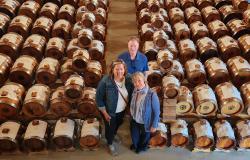If you love cheese, Italy is a good place to be. Each region produces a variety of excellent cheeses; this month, as we’re featuring little-known Friuli Venezia Giulia, we take a look at the region’s signature cheese: Montasio.
Formaggio di Montasio belongs to the (great) group of alpine cheeses. These began being produced around the year 1000, as a way to preserve a perishable product, milk, for periods when food production would be scarce.
Montasio itself dates back to the 13th century, when Benedictine monks started its production in the valleys of the Julian and Carnian Alps of Friuli Venezia Giulia. The place where it all began was the abbey at Moggio Udinese, to the north of the famous Altopiano di Montasio (Montasio Plateau), now used by Clarisse nuns.
The name Montasio was not applied to the cheese until 1773, when the first documents reporting the name appear, also showing a fixed priced at which the cheese was to be sold, quite higher than other cheeses.
Today, Montasio is produced across all four provinces of Friuli Venezia Giulia and has obtained the DOP mark (Protected Designation of Origin): it can only be produced in the region and in parts of the Veneto.
Montasio is a semi-hard cheese (aged longer it develops a harder texture), with a pale yellow to gold color (again depending on age), and a creamy texture.
Made with local cow’s milk, Montasio cheese has four aging times, which will determine its characteristics and use: fresh, 60 to 120 days of aging; mezzano, 5 to 10 months of aging; aged, 10 to 18 months of aging; stravecchio, more than 18 months of aging.
As you progress from fresh to aged, the color of the crust becomes darker, the consistency more crumbly and the flavor stronger, almost spicy.
These different nuances of flavor make Montasio a versatile cheese, to be used in different ways: with first courses, with polenta or to enhance platters of cold cuts and cheeses. But the classic way to eat Montasio in Friuli is frico, cheese in a pan. It is made in two versions: the crunchy one (frico croccante), where the cheese is fried in its own serum and nothing else; and soft frico (frico morbido), enriched with potatoes, and sometimes onions, bacon or herbs. It was the classic meal of the woodsmen, poor but energetic.
To recognize its authenticity, look at the rind: it should have the word “Montasio” written repeatedly across it.

